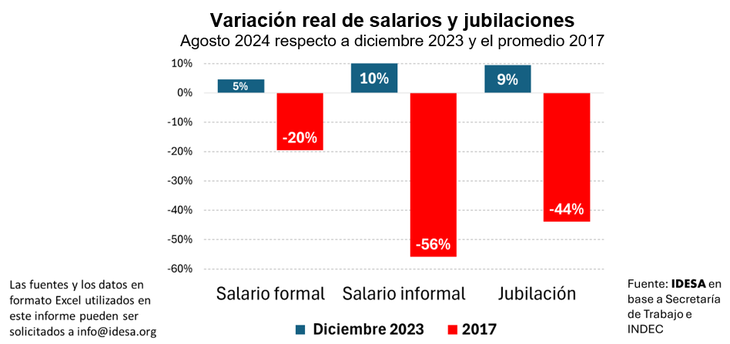After the inflation data for September, the question arises about salaries. The formal real salary seems to be the best compared to December 2023, but they are still far from their historical peak.
In line with the decrease in inflationsalaries are in the process of recovery. This was reflected in a recent IDESA report that set out to analyze the evolution of price-wage relationship to look closely at how much real income recovery there was.
The content you want to access is exclusive to subscribers.
Along these lines, the social institute indicates that, according to the Ministry of Labor and the INDEC:
- He formal real salary currently it is a 5% higher than in December 2023 but 20% lower than the 2017 average.
- He informal real salary it’s a 10% higher than in December 2023 but it is estimated that it is a 56% lower than the 2017 average.
- The national royal pensions are a 9% higher than in December 2023 but 44% lower than the 2017 average.
For Idesa, these data show that so far in the government, the population’s main income – which is salaries and pensions – has improved compared to the month of inauguration. However, they are still very far from the level they had in 2017, which is the level immediately prior to the exchange rate and inflation crisis that was triggered in 2018 and continues to the present. In other words, Family incomes are improving, but the gap with respect to historical purchasing power remains very large.
Screenshot-2024-10-13-132840.png

According to IDESA, family incomes are improving, but the gap with respect to historical purchasing power remains very large.
The same goes for production and employment.. According to the analysis, economic activity shows signs of recovery compared to the sharp decline in the first half of the year, but it is still “i“nsufficient to attract formal employment.” For this reason, registered salaried employment in private companies continues to stagnate and, as has been happening for more than a decade, The only employment that increases is the Monotax and informality.
Private employment in Argentina: the fall continues despite a slight rebound in activity
He private employment in Argentina continues to declinedefying the expectations of the Government, which had promised stabilization in the labor market. According to the latest report of the Argentine Integrated Pension System (SIPA), prepared by the Ministry of Labor, The data corresponding to July 2024 show that the number of employees in the private sector fell to 6,207 million, with a reduction of 8,900 jobs compared to the previous month, which is equivalent to a contraction of 0.1% in seasonally adjusted terms.
The negative trend, which began in September 2023, accelerated in the first quarter of 2024. Although the speed of job losses has decreased since then, the accumulated drop since August 2023 amounts to 180,500 positions, implying a reduction of 2.82% in 11 consecutive months of decline.
Added to this figure are the losses in the public sector, where job destruction began in January of this year. During the first seven months of 2024, 49,400 public sector jobs were cut, bringing the total number of jobs lost in the country to 207,900.
Among the private sectors most affected in July are Hotels and restaurants, with a drop of 0.4%; Agriculture, livestock and forestry, with a hiring of 0.3%; and Community Services and Construction, both with a decrease of 0.3%. Setbacks were also recorded in the financial sector, which decreased by 0.3%.
Source: Ambito
I am Pierce Boyd, a driven and ambitious professional working in the news industry. I have been writing for 24 Hours Worlds for over five years, specializing in sports section coverage. During my tenure at the publication, I have built an impressive portfolio of articles that has earned me a reputation as an experienced journalist and content creator.




